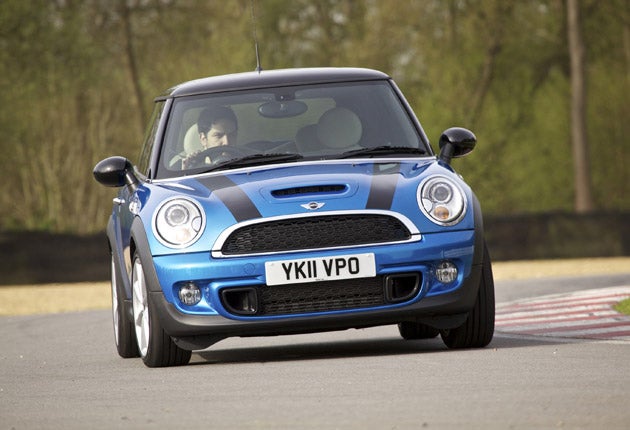Mini SD
The 2.0-litre turbodiesel goes like a dream in the SD – but big doesn't mean better in all models

If we're not careful, absurdities can occur without our realising their gradual development. Drip, drip, drip go the little changes, until suddenly you realise that something ludicrous has happened.
A car called "Mini" is all about smallness, you would think. In relative terms a current Mini hatchback is indeed quite small, but in absolute terms it is quite large and poorly packaged. We've got used to it, and the Mini name retains some credibility. But not a lot; the recently launched Countryman derivative is absurdly huge – its cabin is practically big enough to swallow an original, real Mini whole.
And now there's the option of a new 2.0-litre turbodiesel engine in all four Mini body shapes (hatchback, convertible, Clubman estate car and Countryman SUV). Two litres! In a Mini! Oh Lord, what have we done?
I'm often in this frame of mind, railing against new cars' corpulence, but I feel it particularly sharply here. This is no doubt because I have just bought myself a new toy, a proper 1959 Mini from the year of the breed's birth and fitted with a supercharger. It looks standard but has about 80bhp, so is very amusing. It is also extremely small outside while having, shoulder width apart, as much space inside as the current Mini hatchback. If it seemed a miracle in 1959, it's even more of one now with its tiny 10in wheels and 600kg mass.
It's a neat coincidence that I acquired this forced-induction, ie supercharged, Mini in the same week that I sampled the new forced-induction, ie turbocharged, Mini Cooper SD. Mine goes as fast as an original 1960s Cooper S, while the new diesel one (starting from £18,750) has even more torque than the current Cooper S.
The new engine's peak power is 143bhp, its torque is 225lb/ft, and in the lightest Mini-shape (the hatchback) it will fire the car to 62mph in 8.1 seconds and on to a top speed of 134mph. My little Mini certainly can't compete with that, nor will it get anywhere near the new diesel car's frugality (65.7mpg official average, 114g/km CO2 output) although it will match the free road tax because it's a historic pre-1973 car.
How, then, does the new engine feel in the modern Mini? This SD has all the visual kudos of the petrol S, including the air intake in the bonnet which in this case is real (it feeds the turbocharger's intercooler), and you can even order a Sports Pack to make it look and feel – engine apart – like the ultimate Cooper S, the John Cooper Works.
But whereas a petrol-fuelled Cooper S feels crisp, eager and keen to rev, and emits a pleasing growl from its exhaust pipe, the Cooper SD is more languid in its demeanour. On a fast road with open, sweeping bends you seldom need to drop below fourth gear. In an SD hatchback the engine feels just right for the car, with a deep but quiet note and easy overtaking ability. Never has a Mini been more effortless.
It works well in the SD Clubman, too. Neither car feels nose-heavy, despite the engine's large capacity, because the block is made of aluminium instead of iron. The hefty, heavy Countryman, however, defeats even this engine's enthusiasm. Here it feels more lethargic, taking longer to build up its turbo boost and emitting a gruff background grumble.
All have a Sport button which sharpens the accelerator response, is supposed to make the engine sound "sportier" (I couldn't detect a difference) and adds weight to the electric power steering's movement. This last change is most unpleasant, simply giving the impression of thick, sticky grease in the mechanism.
More development is needed; if it helps, I'm willing to lend my old Mini to remind the engineers how steering is supposed to feel. Meanwhile, the Mini Cooper SD stands alone as a modern small car with an engine you'd expect to find in a big one. Will any other carmaker follow suit? All their Mini-rivalling cars are near the bottom of ranges containing bigger cars, which would then be made to look inadequate. Looks like the Mini SD has the field to itself.
The Rivals
Alfa Romeo Mito 1.6 JTDm Veloce: £16,875, 120bhp, 126g/km
Dumpy but cute, with cartoonised Alfa styling, it exists more as a fashion accessory than sporting supermini.
Audi A1 1.6 TDI S-line: £17,865, 105bhp, 105g/km
The frugal A1 is a good little car with pleasing electro-hydraulic steering. Sport is more comfortable than top S-line.
Citroën DS3 1.6 HDi DSport: £16,300, 110bhp, 118g/km
The Germans don't like Citroën treading on their premium toes, but the DS cars do it convincingly. This DS3 looks good and is fun to drive.
Join our commenting forum
Join thought-provoking conversations, follow other Independent readers and see their replies
Comments